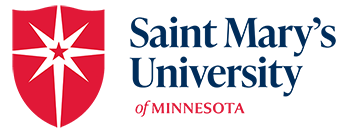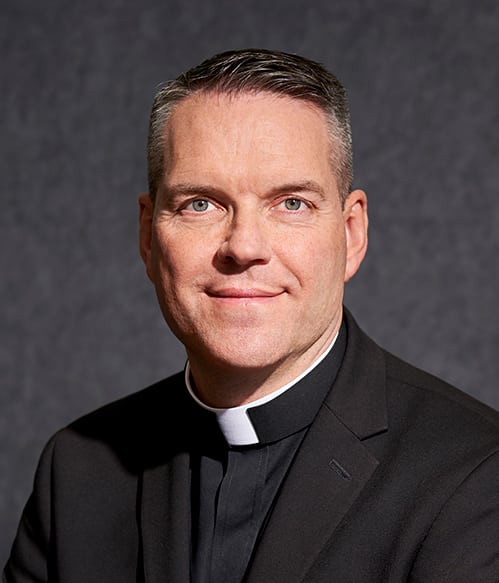Saint Mary's Newsroom
Campus ConnectionAn update from the president to alumni and parents
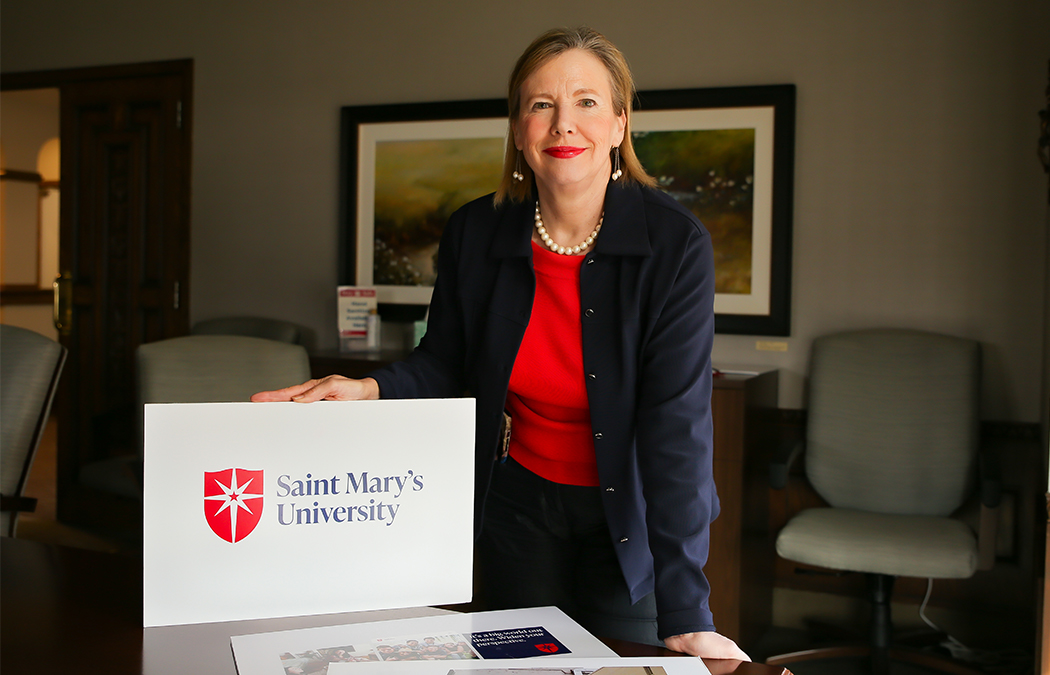
University unveils new look and distinct, but familiar, messaging
Kelly Shannon, vice president of marketing and communication, stands behind Saint Mary’s brand.
Saint Mary’s is rolling out the results of a branding refresh in June, and yes, there’s a new logo, but Shannon explains that branding is so much more than a logo: “A brand is the sum total of all of the images and feelings that someone holds about an organization and its services or products,” she said. “A brand is our promise, and our audiences determine whether we deliver on that promise.”
Higher education is more competitive than ever, with universities and colleges all going after fewer students. “We are mindful that we don’t have endless resources to tell our story and get that story heard,” she said. “Our challenge, which is fun to take on, is telling our story in a creative way to interest and captivate those we are trying to reach. It comes down to three ‘c’s: being consistent, clear, and compelling.”
What is a brand?
“A brand is not what an organization says it is, it is what our intended audiences experience, perceive, and believe,” she said. “What is the experience that our students have, students who range from 17 to well into adulthood or even retirement? While each student has their own educational experience, there are common outcomes and benefits that we want all students to have at Saint Mary’s.”
Further, she said the brand is shared and solidified at every major touchpoint, from the website, to a campus visit, to every interaction a potential student or current student has in the classroom and with staff and faculty across the university. According to Shannon, we are all brand ambassadors. “Branding starts internally,” she said. “If we all know and tell our story consistently, we have a great opportunity to make the case to a prospective student about ‘Why Saint Mary’s?’ ”
Strong university brands also have alumni, employees, and current students who express their pride, ownership, and passion for their school. According to Shannon, “Alumni pride goes a long way toward building awareness, excitement, and affinity for a school. One of the leading indicators of a strong brand is the answer YES to the question: would you recommend this (organization, company, product, service, program) to someone else?”
Time for change
The rebranding process began a year ago. The process is lengthy, mainly because of the research done with current and prospective students, faculty, staff, and alumni to help define the brand.
“Our external partner, who is also doing our web redesign, did extensive quantitative and qualitative research,” Shannon said. “They then created a visual identity that represents the attributes important to our community. A lot of listening goes into creating your visual signature in the marketplace. Because a brand is what our audiences say it is, the messages must be true, authentic, and relevant to them.”
As you noticed on pages 4 and 5, Saint Mary’s is launching a new logo and updated seal. Additionally, new fonts, overall photography and design looks were established, and a new color palette is being unveiled. For the first time in its history, Saint Mary’s primary color is navy blue.
“Our primary colors remain red and blue but we’re leaning more heavily into blue,” Shannon said. “The blue is bold and classic, yet contemporary. And it stands out in a market where many universities in our competitive set have red as the lead primary color. As a university with a long legacy and strategic vision, we want both to acknowledge the strong heritage and say we are agile and responsive to the needs of our future students.”
Ever mindful of financial resources, the new logo and seal will roll out in phases. The branding effort was funded through reallocation of existing marketing funds so did not require additional funding.
“Walk the campuses and you will see branding everywhere, so we have to be very planful about how we launch the new visual identity without having it being financially onerous,” Shannon said. “A brand drives reputation, which in return drives revenue (enrollment, giving), so phase one is getting the new branding in front of external audiences.”
Also, still to come, is a brand new web redesign, slated to roll out by fall.
“The new website’s primary audiences are our many and diverse prospective students — from traditional undergrad and transfer students to adult bachelor’s completion seekers to graduate and professional learners,” Shannon said. “Best practices in website design call for excellence in content, navigation, and design. How do we provide a prospective student, wherever they are in their learning journey, to quickly find what they want? Too many clicks and they are gone, so what is the easiest and most intuitive navigation? Does the design entice and tell our brand story? Does it compel them to stay on the site and visit other areas? And is the content clear, relevant to what they want and need, and interesting?”
Our pillars
Shannon explains there are five brand pillars that describe who Saint Mary’s is and what sets it apart.
- Lasallian Catholic values create real value.
- Faculty and staff are all in for every student.
- A community that cares.
- Education that’s within reach.
- Practical, hands-on education for the real world.
“Those pillars should be familiar,” she said. “We hope this is exactly the experience our alumni had as students. Part of the refresh is a recommitment and a refocus and actually stating our brand clearly and concisely.”
Shannon believes now is the perfect time to refresh the Saint Mary’s brand. “We, and all of higher ed, are facing challenges, with declining enrollment due to COVID-19, and with a smaller pool of potential undergraduate students on the horizon,” she said. “New branding, a new website, and cleaner, crisper messaging increases visibility. The goal of branding is to provide a clear and positive sense of what we offer. When a prospective student is researching or deciding on colleges, we hope to have caught their attention and interested them. If our brand resonates with their values and the outcomes they are seeking, we should minimally be in the mix of their decision making and hopefully the ultimate choice.
“Saint Mary’s has a strong value proposition, especially in our Lasallian Catholic vision of education, and this is our opportunity to articulate that well,” said Father James P. Burns, IVD, Ph.D., Saint Mary’s president. “We meet students where they are along their learning path and support them with excellence in a real-world educational experience that prepares them to work, lead, and serve with character and purpose. By telling our story clearly, consistently, and compellingly in a way that is relevant and resonates with our various audiences, we have a very bright future ahead.”

Fastenal internship puts Swanson on fast track to career
By their senior years, many college students are starting to panic, wondering if they’ll be able to find a job after graduation, whether they’ll enjoy the path they’ve chosen, and if they’re truly prepared to take the first big step in their careers.
Parker Swanson isn’t panicking.
The Saint Mary’s University senior, who is triple majoring in marketing, management, and business intelligence analytics, spent his summer in an immersive solutions analyst internship at Fastenal, a global industrial supply company, headquartered in Winona.
And, between his applicable classroom experience and the well-rounded experiences he’s had at Fastenal, he knows he’s set for a career in sales — and that his résumé is looking good.
Beyond the opportunity to play hockey, it was the co-op program between Saint Mary’s and Fastenal that secured his admission choice. “No other schools that I had been looking at had an experience like that. So it was actually a big pull for me to come to Winona,” he said.
When it came time to look for internships, he knew he would apply to Fastenal for the best possible experience and international name recognition.
Jeremy Johnson, director of operations for Fastenal company for the FMI technology innovation team, says typically anywhere between four and 10 students apply for an internship in his area each semester.
“Some of the qualities I look for in interns generally start with experience,” he said. “I’m looking for experience in extracurricular activities, experience in prior work history in high school, or even volunteering. So something outside of the norm that shows us that a student is putting themselves out there.”
Johnson said over the years, he’s picked up a few shared traits Saint Mary’s students bring to their internships.
“I feel like they’re good communicators, verbal and written, and that can be hard to come by,” he said. “I also think they bring a level of integrity, which is really important in today’s society, and especially in our company. But then also, I feel like they’re inquisitive. So they asked good questions, and that’s important for any job that you take on.”
Throughout the summer, Fastenal interns have an opportunity to work through a myriad of business processes and roles.
“We actually put them through administration, project coordinating, what we call product testing, and the installation process for our technologies. And then we bring them into our innovation team, where we do research, we work on product development, and new project management, along with a little bit of quality and engineering,” Johnson said. “So they get a very diverse view of business, as it relates to our technologies that we support.”
“Getting an opportunity to work in a real world experience is something you don’t get in a lot of university settings,” Swanson said. “And I think Saint Mary’s close partnership with Fastenal has allowed a lot of different students to have opportunities … to understand what they like and what they don’t before they even get to that point of finding a job and job searching. Working with five different teams this summer, all the way from administration to innovation supply chain, helped me understand what I like, what I’m good at.”
Johnson agrees that it’s valuable for interns to get work experience prior to going out into their chosen careers. It’s also a win-win scenario for Fastenal as they look for potential career placement.
“Most interns have an opportunity for future placement full time after the internship is done or continued part time work if they choose,” he said. “We have anywhere from 1,000 to 1,500 job openings at any given time all over the world. So when you look at our organization, and you consider the term business, what aspects of business are you interested in? And where would you like to live? And generally speaking, we would have lots of opportunities for those interns.”
In fact, he said, Fastenal employs many Saint Mary’s alumni who have been working there for decades.
Swanson said he’s currently applying for a few different roles with Fastenal and is also looking at other opportunities outside of Fastenal to see which environment suits him the best. Either way, he’s incredibly grateful for the experience.
“Fastenal is one of those companies that everybody knows … putting that label on a résumé is a huge résumé booster. I think I want to take those skills that I’ve learned … and transfer those into the sales world, whether it’s at Fastenal or somewhere else. I’m ready to take that next step.”

Saint Mary’s MBA alumnus helps Black community reduce wealth and homeownership gaps
Growing up in Louisville, Ky., Vachel Hudson M’19 was familiar with Saint Mary’s College of California because of its successful athletic teams. After moving to Minnesota and receiving his undergraduate degree, he began looking at MBA programs. He was familiar with the Saint Mary’s name, just not Saint Mary’s University of Minnesota. But he quickly realized it was a respected and well-known program in the state.
“I was recruited to move to Minnesota and work for Aeon, an affordable housing provider, after helping the City of Louisville land a $32 million grant to increase affordable housing options,” Hudson says. “I really liked the MBA program’s low barriers to entry, including not having to take the Graduate Record Exam (GRE), and the flexibility to take classes virtually and start and complete it quickly. I took three classes every five months, so I could advance my career.”
The flexibility was important for Hudson, who took his studies with him when traveling and while working evenings. Hudson also liked the low student-to-teacher ratio, which allowed him to get feedback on his work, and he appreciated the university’s approachable MBA program director, whose direct communication style helped him achieve a 4.0 GPA.
Applying real-life business concepts
Several very valuable courses stand out in Hudson’s mind, including Marketing Strategy, Project Management, Quantitative Decision Making, and Finance. He uses combinations of these classes every day in his personal and professional life.
“I wanted my MBA so I could gain a general understanding of how businesses and departments operate, so I could understand ‘the blueprints and the bones,’ how the parts help the overall operation,” Hudson said. “The fact that I could apply real-life business concepts helped me grow so I could show an organization how it could improve, and it prepared me to step into an organization and improve its product and processes.”
While working on his MBA, Hudson took a job with the Urban League Twin Cities. There he helped people prepare for homeownership, learn the differences between owning and renting, help first-time homebuyers navigate the process, and help improve credit scores so they could buy a home or start a business.
In March, Hudson joined First Independence Bank in Minneapolis, the first and only Black-owned bank in Minnesota and one of only 17 Black-owned full-service banks in the country. The bank was started as a response to George Floyd’s murder by police in 2020. Hudson focuses on homeownership and oversees mortgages in the Twin Cities.
Building Trust and Relationships
In addition to his work at First Independence Bank, Hudson works as a life insurance broker/agent to support personal wealth development. He’s also a full-time volunteer as president of Urban League Twin Cities’ urban young professionals, where he oversees the chapter’s 60+ members who volunteer their time, talent, and treasure.
“As founder of Reinvesting in Communities and Housing, we help build relationships, we help build relationships between Blacks and financial institutions and help them build trust and awareness of financial resources,” Hudson said. “We’re reinvesting in communities, improving financial literacy, and helping people connect with the right resources to facilitate homeownership. I’m a bridge builder.”
Hudson credits Saint Mary’s for preparing him to communicate effectively, manage a team, and apply concepts to real-world work. He also gained the ability to interact with a range of diverse classmates (in age, race, and backgrounds), while helping him navigate the real world and learn to market himself and apply managerial concepts.
“If you’re considering Saint Mary’s MBA program, don’t think about it, just do it. If you appreciate a small ratio of students to instructors, I’d highly recommend it,” Hudson said. “There are low acceptance barriers and not the same requirements as other programs. I’d also love to be more involved with Saint Mary’s alumni events.”

Sandbar Storytelling Festival adds Koo Koo Kanga Roo to fall lineup
WINONA, Minn. — The Sandbar Storytelling Festival welcomes the interactive dance party duo Koo Koo Kanga Roo for an evening of moving to the music on Saturday, Oct. 15. The show, sponsored by Todd VonBastiaans and Winona Area Public Schools, will run from 5:30 to 6:15 p.m. (with doors opening at 5 p.m.) in the Winona Middle School auditorium.
Koo Koo Kanga Roo, based in Minneapolis, consists of two Saint Mary’s University alumni, Bryan Atchison and Neil Olstad, who formed a campus rock band back in college. In 2008, the duo began touring and putting on shows at bars, basements, and barbecues.
Meanwhile they released their first few albums and music videos. In 2010, the band was chosen to support Orange County superhero rock band The Aquabats on their east coast tour. This turned into more support slots with Reel Big Fish and Yo Gabba Gabba Live. Meanwhile Koo Koo began creating “dance-a-long” videos to aid in audience participation.
These videos were unexpectedly a hit with elementary school teachers, which led Koo Koo into the world of children’s music. More domestic and international touring followed as the guys hit the road with The Vans Warped Tour, Frank Turner & Sleeping Souls, and MC Lars.
Concept albums about cats, potty humor, self-help, holidays, and Panera Bread added to the band’s discography. Simultaneously, the popularity of their “brain break” dance-a-long videos continued to skyrocket in classrooms around the world. In 2021, the two released, “Slow Clap” — a more hip-hop-centric sound with plenty of grooving bass lines and monstrous drums, while retaining the catchy, weirdo-energy fans expect from the band.
A favorite among school children everywhere, Koo Koo Kanga Roo connects with audiences of all ages who just can’t help but sing and dance along to their delightfully silly lyrics.
Tickets, which will go on sale Aug. 1 at www.sandbarstorytellingfestival.org, are $15 for adults over 16, $5 for kids 5 to 16, and free for children under 5 years old. Pay-as-you-can tickets will be available on-site 20 minutes prior to the performance.

Alumnus focuses on aiming high
From his new office at Goldman Sachs in Tucson, Ariz., Javier Madrid B’18 describes his shoot-for-the-moon philosophy. He believes in aiming high. His philosophy is that if you fall short of your goal, you’ll still end up in a good place.
Madrid grew up in Naco, Ariz., and had just moved to Tucson, Ariz., at the age of 13 when he had the opportunity to participate in Saint Mary’s inaugural Countdown to College (C2C) four-year summer program through San Miguel High School (Cristo Rey Network).
He credits C2C, the broader FGI program, and the program’s first administrators, Jane Anderson and Edith Galvez, with changing his life.
“First off, from where I’m from, statistics are very grim as to how many people go to college and graduate,” he said.
He’s also grateful for the lifelong lessons he learned from his peers in the program. “I grew up in a predominantly Hispanic neighborhood and went to a high school that was mostly Hispanic, so C2C exposed me to different cultures,” he said. “It’s where I began to expand my horizons, and it helped me put myself into other people’s shoes. Some of my best friends are from Chicago and had their own sets of challenges. It gave me the gift of perspective, which is so important, especially in the professional world. And in society, particularly in this political spectrum, we all need to take a second to listen. There’s an opportunity to build bridges and build one another up. We work better in teams.”
It’s this team atmosphere that, Madrid said, supported him for eight years through the C2C and FGI programs.
“The C2C program helped prepare me for high school because I technically went to college before I went to high school,” he said. “It showed me the importance of time management, and prioritization. And when I got to college, it was nothing new. Aside from all the academic courses, in grammar, math, and science, the C2C program showed us what a college environment is like. In my last year of C2C, we conducted a science project on clean water and the variables that affect its accessibility. This is the type of activity that catapults you into the college atmosphere because you’re presenting to tenured professors with Ph.D.s.”
Being chosen as an FGI Scholar and being able to attend Saint Mary’s on a full scholarship, Madrid said, meant the world to him. “It was emotional,” he said. “When I reflect on all the sacrifices my parents made, working late nights and extra jobs, how they sent my sister Yvonne and I to Tucson for the opportunity at a better life, I acknowledge all the sacrifices my family made for me and how they led to additional opportunities.
Madrid is thankful to Jack and Mary Ann (Wera) Remick CST’64 for generously supporting the program from the beginning.
“They’re amazing individuals,” he said. “By the time I graduated, I understood a lot more about the commitment people made to me and my peers and the money and time they invested in us to push us and provide us with the resources to be successful. With every passing day, you appreciate that more and more.”
And, he’s grateful to the De La Salle Christian Brothers. “I can never repay the Brothers for what they’ve done for me and my family. I’ve been able to see and grow so much. I was chosen to travel to Washington, D.C., when Pope Francis visited and was also selected to go to Rome as a Lasallian Leader. The Brothers bring so much to the school’s culture.”
It has always been important to Madrid that he not let anyone who has believed in him down, and that hard work ethic has extended to his career.
After moving back to Arizona to be closer to his family, Madrid began working in management in the paint industry before switching to commercial insurance. About a year ago, he had an opportunity to join Goldman Sachs & Co. as an analyst.
He now works in wealth management, helping clients reach their investment goals through financial planning and investment management. “It’s one of the top financial firms in the world, and working here has been a life-changing experience,” he said.
Another life-changing experience was the birth of his daughter Kamila in fall 2021.
“I feel like it’s a dream come true,” he said. “I have a long way to go but feel like I made it and if I wouldn’t have dreamed it and aimed high, I wouldn’t be where I’m at today.
“Saint Mary’s obviously gave us a quality education but one of the most important things is the type of people they graduate. We’re adaptable and excited about learning. It produces young, productive, passionate, and caring young men and women.”

Surrounded by support
Family is everything to Jacqueline (Jacky) Beltran ’24.
After losing her father to cancer her senior year of high school, the connection between her, her mother, and her now 5-year-old little sister became even stronger. Love carried them through the tragedy.
So when she began applying to colleges, the idea of moving away from their Waukegon, Ill., home definitely wasn’t an option. The farthest she’d ever traveled was just over the border into Wisconsin.
But the opportunity to be one of Saint Mary’s University’s First Generation Initiative Scholars eventually persuaded her to step out of her comfort zone.
Established in 2010, the Saint Mary’s First Generation Initiative (FGI) was designed to address a growing academic achievement gap, particularly in under-resourced, diverse communities. The program helps ensure academic success for high-potential, first-generation students in partnering schools. Programming supports students from middle school through college graduation. FGI Scholars receive scholarship support not covered by financial aid.
Beltran was not part of the high school Countdown to College summer preparation program. Instead, she was introduced to the FGI program by her high school guidance counselor. She hadn’t thought much about college in middle school, but at Cristo Rey St. Martin College Prep, with encouragement, she realized a college education would brighten her future.
“I had never thought going out of state was an option because I am really attached to (my family),” she said. “I applied to two other schools in Illinois. I’d never been this far from home. Once I heard about the scholarship at Saint Mary’s, I knew it was an opportunity I had to take.”
When Beltran heard she was accepted as a First Generation Initiative Scholar, she admits, it was emotional for her and her family. “I read the email like 30 times,” she said. “When I got it, I was in shock and called my mom, and we both cried on the phone. My Mom had encouraged me. It was a future she wanted, and she wasn’t able to get for herself. It was an opportunity I was very thankful for and am still thankful for.”
Beltran’s father also proudly learned of his daughter’s accomplishment before his passing. “He hugged me. He didn’t see me cross the high school graduation stage, but he saw my diploma. It was an emotional roller coaster.”
Once she settled in Winona, Beltran quickly found the FGI program was about more than a scholarship. The sophomore psychology major says the community support and relationships have helped her grow and accomplish things she never would have otherwise.
“Being an FGI Scholar is an awesome opportunity,” she said. “I’m not very social. I wouldn’t have been interacting as much on campus without the encouragement and support I’ve received. I’m thankful I’m more involved on campus. I’m a guided study mentor and peer learning assistant. I’m also the social media manager for the psychology club, and next semester I’ll serve as vice president.”
Not one to normally reach out for help, she said she also found the academic support she needed at Saint Mary’s. “They helped me with questions personally or academically,” she said. “If I was struggling with a class, they guided me to resources like tutoring or connected me with upper classmen. It’s a small community and professors are really supportive. Last semester I had a tough time mentally. I was homesick. Faculty here acknowledge you and pay attention to what’s going on in your life.”
Through her courses, Beltran is learning more about herself and her interests. She started out thinking she wanted to major in zoology and work with animals. She quickly changed to psychology after loving her first courses. This year, she completed research classes, and next semester, she will learn more about specific disorders and the clinical psychology aspect. “I’ll see both aspects before deciding where I want to go with my career,” she said. Regardless, Beltran has always felt a calling to help others, and believes psychology is the right path forward.
“If it were not for the FGI program, I wouldn’t be where I am in my life. It’s a supportive community that is always there for me. This is a height I didn’t know if I would ever get to.
“I’m very thankful. This is a once-in-a-lifetime opportunity. I feel like they’re really helping us accomplish our dreams and our families’ dreams. They’re brightening our future.”
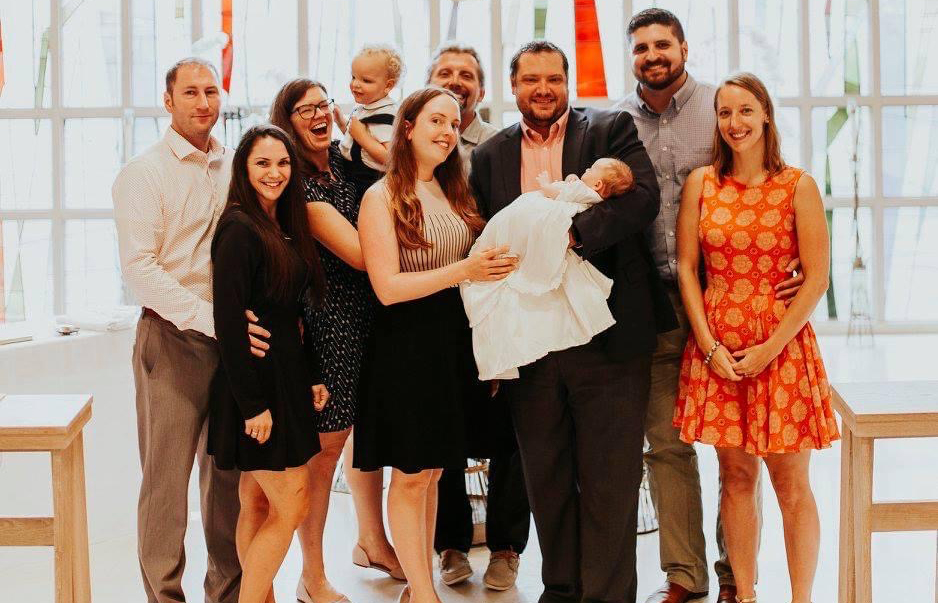
A community that cares
For Sarah (Marek) Landman B’04, M’07, Saint Mary’s has always been a second home. A Winona native whose parents, Patrick B’79 and Maureen (Randell) ’81 Marek, as well as several aunts were all alumni, she was introduced to the Saint Mary’s community early in life. Running around her parents’ regular reunion get-togethers, she would frequently overhear her parents and their lifelong college friends laughing and reliving memories. Older brother Mike Marek B’07 also attended.
Also as a child, she began acting. At 6, she was involved in a community theatre performance that was the first performance in the “then” new Page Theatre on campus. As an eighth grader, she was cast in a Saint Mary’s performance and experienced first-hand the “culture and sense of caring” that theatre students had for one another.
When it came time to choose a college, she said she truly felt like Saint Mary’s wanted her to be part of the community. “Between Anthony Piscitiello, AFSC B’69, M’82 (then vice president of admission) reaching out and my admissions reps who would send me clippings every time I won an award or made the honor roll, and the fact my mom and dad went there, and a bunch of my aunts, it was a very comfortable and natural place to be,” she said.
Landman would soon discover she had many of the same experiences as her parents. She too enjoyed staying on campus during the summer. A theatre major, Landman worked in the admissions office and for the box office and enjoyed the true beauty of the campus. “I showed up as a freshman and never really went home,” she said.
“I felt cared for, and very much known,” she said. “Professors I didn’t even have classes with still knew my name. I can still see Jerry Seibert at Campus Safety; the women at the registrar’s desk; and everyone at the switchboard and in the cafeteria. Everyone was just so welcoming of all students. At Saint Mary’s, no one is anonymous.”
Eighteen years later, she, like her parents, stays in close touch with the friends she made on Terrace Heights. “Beyond the Theatre Department, I met a good group of friends from my residence hall,” she said. “I’m still friends with them, and I’m godmother to one of their children. We’ve been there for each other through marriages, having kids, and losing parents. We were there for each other during tough things; 9/11 occurred when I was a sophomore. That’s a good example of how the community rallied together during a traumatic event. The chapel was packed, we all went to an assembly and were encouraged to give to relief efforts.
“The Taylor Richmond Benefit started while I was a student, and I remember how supportive the community was of the Richmond family during their journey with Taylor (the benefit’s first recipient). When there was a need on campus, students responded with the resources they had, as well as prayers and support.”
Landman said when she compares her college memories with others, she finds no one else, who attended other universities, had the same experiences she did of a tight knit community and lifelong bonds.
Landman has also seen it from the graduate perspective.
Her first job out of college was in development at Saint Mary’s. An added bonus of her position, she was able to earn her Philanthropy and Development degree from the university.
She recalls being part of a supportive cohort. “I was at more of a junior level than most people,” she said. “Studying alongside professionals, I learned so much from them, and we’re all still in touch. My cohort has had four or five Zoom calls since COVID-19 began. We send each other Christmas cards. It was a different experience as a graduate, but the heart of it was still the same, that same sense of caring and community, everyone willing to share knowledge and contribute.”
Now a university trustee, Landman takes the honor and responsibility very seriously. “It’s important for me that Saint Mary’s is able to do what it did for me for future generations of students,” she said. “The faith component is behind a lot of the sense of community. At the root of being Lasallian Catholic is being good to each other, being kind, being a good human, and treating people like you want to be treated. That was at the core. It’s important to me to be a trustee of an institution that is faith based and is encouraging people to keep their faith. Under Father Burns’ leadership, it’s one of the things that energizes me. Saint Mary’s is a place where Catholic students can come and grow in their faith and not take a step back from it. And learning ethical values and leadership is more important than ever.”
The executive vice president of Insightful Philanthropy, Marek Landman said she knows that in the business community, you learn that ethical behavior isn’t always the norm. “This world needs more ethical leaders. There’s no better place to get a great community, a strong foundation, and grow in your faith than Saint Mary’s.”
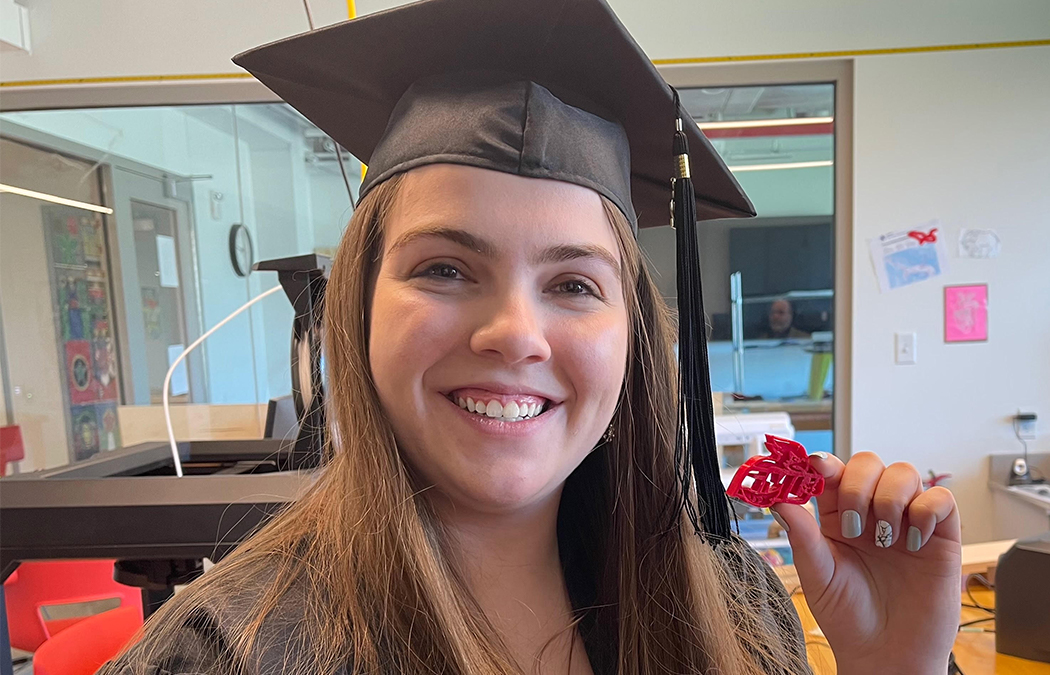
Makerspace is the place where ideas come alive
There’s a place at Saint Mary’s where safety goggles are often a necessity, and getting your hands dirty is encouraged.
Housed in Aquinas Hall, the Anthony B’59 and Sandra Adducci Family Makerspace serves as a collaborative workspace equipped with 3D printers, woodworking tools, sewing machines, and more for students to express their creative, innovative ideas, and entrepreneurial interests.
“In the Makerspace, we really like to emphasize that students can come in and get their hands dirty,” said Kacey Davitt, the Makerspace coordinator.
Unlike labs that are tied to a specific class, all students are able to use the Makerspace. 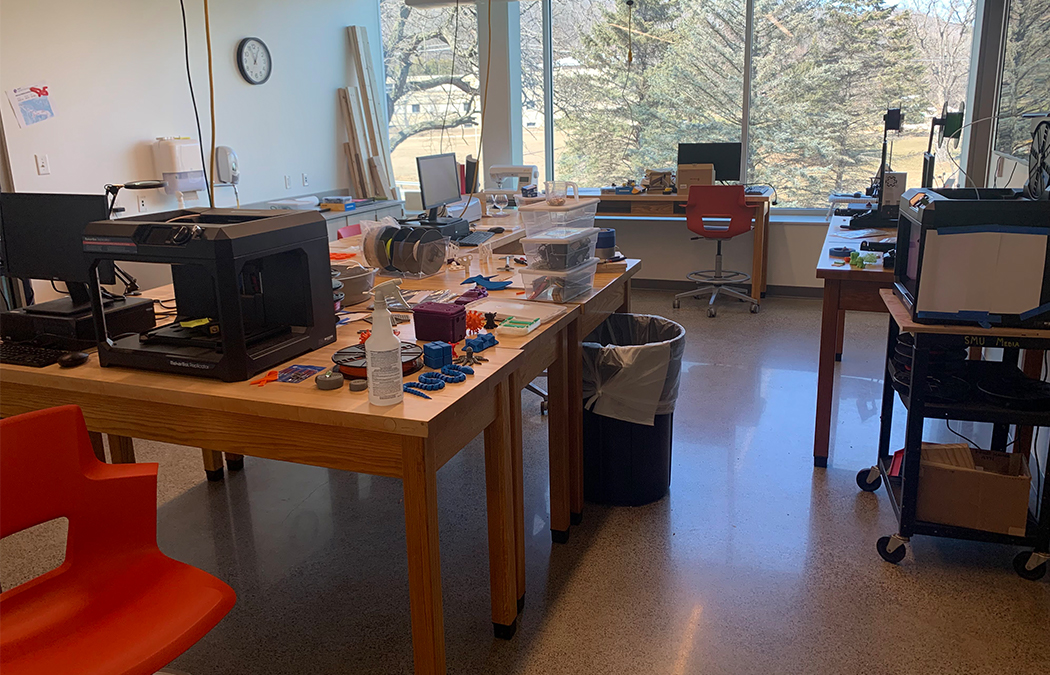
“We really like to focus on the interdisciplinary opportunities in the space,” Davitt said. “We’re not connected to a specific department. We really want to get all kinds of different students in there and focus on the co-curricular aspects of their education.”
From stained glass projects to Halloween costumes, Davitt has said she has seen a number of unique items come to life inside the Makerspace. However, one of the more unique projects to come out of the Makerspace is a successful micro business started by recent graduates Delaney Calabrese B’22 and Jordan Modjeski B’22.
Calabrese and Modjeski, both members of the women’s hockey team this past year, began 3D printing Saint Mary’s keychains as a fundraiser to help purchase a T-shirt gun that could be used at women’s hockey games. The idea and design for the product came from a one-of-a-kind Saint Mary’s Cardinals keychain that Calabrese’s friend had printed for her.
“People always asked me ‘Oh, did you get that in the bookstore? Where can I get one?’ and I had to tell them that it was a one-off my friend had made for me,” she said. “Once we had access to the 3D printers, we purchased our own material and started printing them for people we knew.”
Word spread about the keychains, and eventually, so did the demand for them. After selling the items to their peers, Calabrese and Modjeski were approached by the university’s admissions office, which began handing out the keychains to prospective students. According to Calabrese, the popularity and demand for the keychains spread mostly through word of mouth. 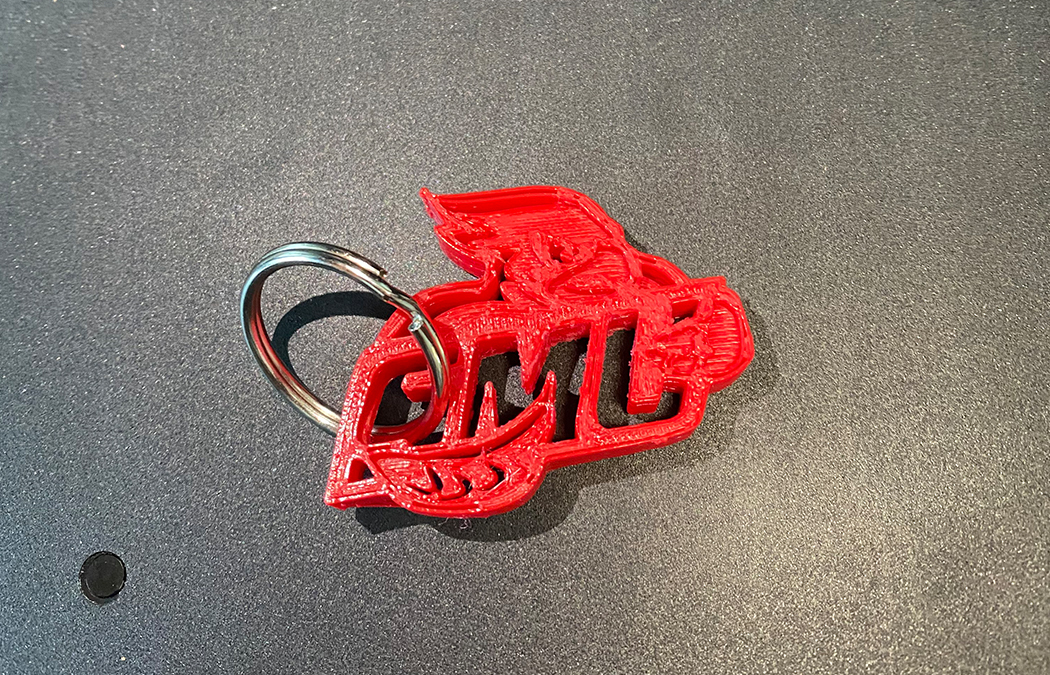
“Once people got their keychains, they would put them on their keys and their backpacks, and they would also post photos of the keychains to social media,” she said. “We didn’t even have to reach out to people. They were reaching out to us and being like, ‘Hey, I’d love to buy one of your keychains. When can I get one from you?’ ”
Over the course of the business, the two printed between 900 and 1,000 keychains.
While operating the microbusiness from the Makerspace, Calabrese had the opportunity to watch the skills she had acquired as a business and data analytics, international business, and marketing major come to life.
“When we were running the business, we needed to make all kinds of decisions, and using what we learned in the classroom helped us make better decisions,” she said.
For Davitt, seeing students learn and grow is the purpose of Makerspace. Not all of that learning, she said, is tied to the classroom. 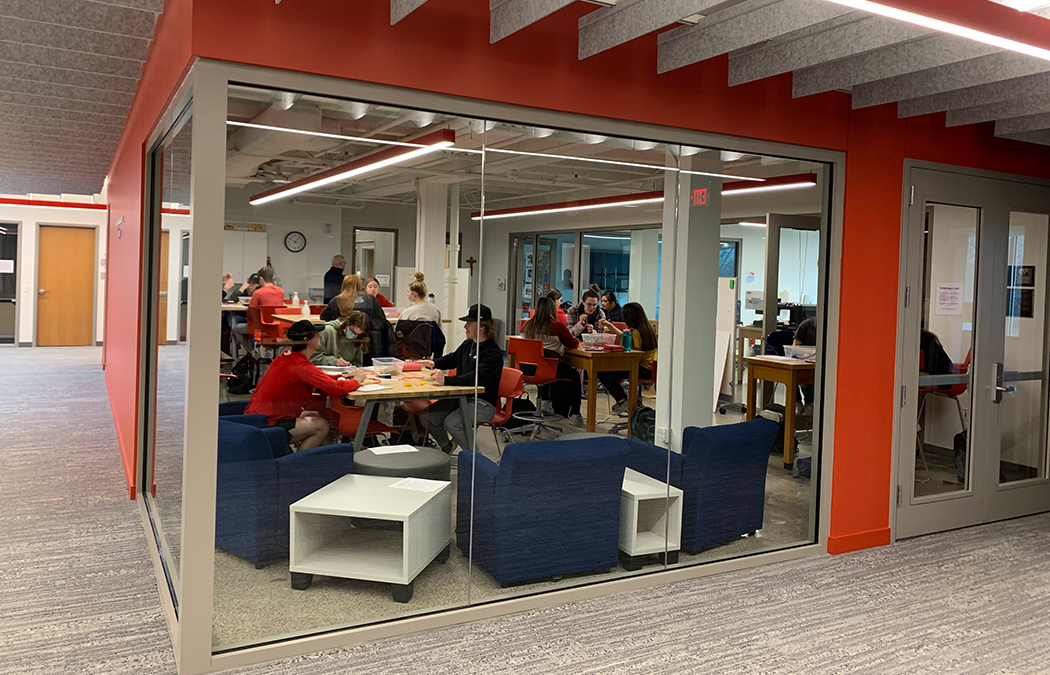
“At a university, you know a lot of our students probably already know calculus,” she said. “But if you hand them a screwdriver, they may not know whether it’s a flathead or Phillips. So having the Makerspace gives them exposure to tools and items they may not be familiar with in a hands-on, tactile way.”
To Davitt, the Makerspace is now an additional part of what makes the Saint Mary’s experience so unique to its students.
“I think it’s really beneficial for students to get out of the traditional classroom,” she said. “We really want the Makerspace to be an extra resource for our students.”
Calabrese agrees with Davitt and urges every student at Saint Mary’s to take advantage of the hands-on campus resource.
“Outside of using it for academic purposes, it can be a great place to be creative, try new things, and have access to tools you wouldn’t normally be able to use like a laser engraver or 3D printer,” she said. “On top of that, the staff in the Makerspace is amazing. They’re always available and willing to help you with whatever you’re working on, which makes the space even more amazing.”
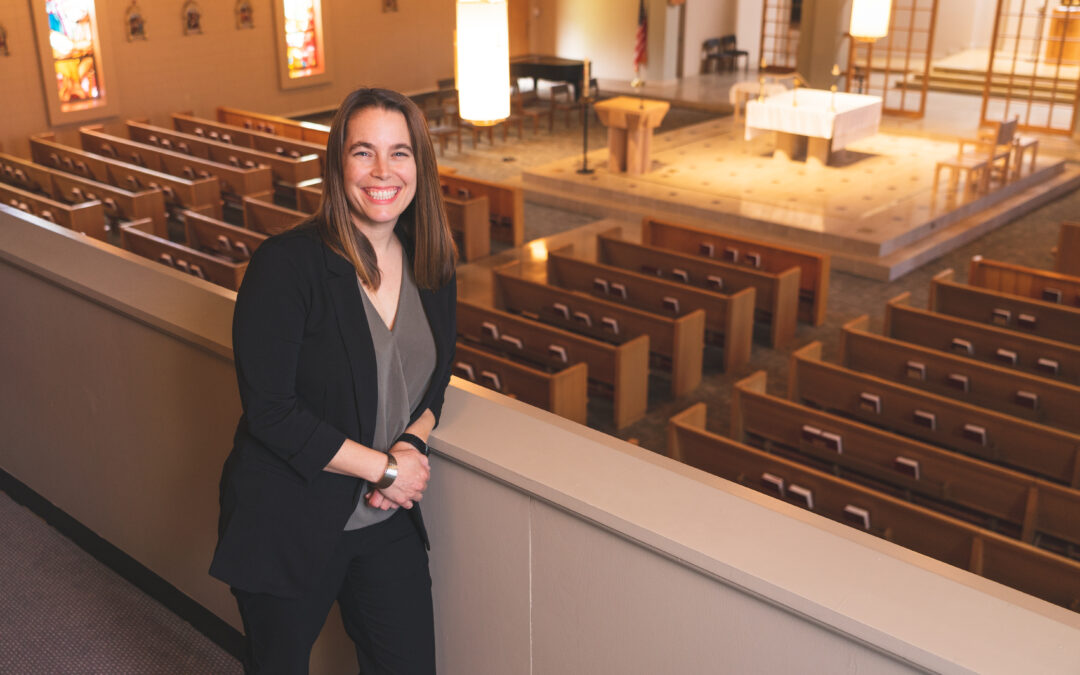
Lasallian Catholic values
When students come to Marisa (Niemiec) Corcoran B’99 and ask the tough questions about faith and religion, her answer is clear and simple.
“My philosophy is love,” she said. “I’m going to show them so much love and show them God loves them. Conversation is important. We invite people to be honest about where they are. We open the door.”
As the director of Campus Ministry at Cotter Schools in Winona, she wants her door to always be open — mirroring the same welcoming atmosphere she experienced at Saint Mary’s University.
Coming from a Lasallian high school, she admits she never considered Saint Mary’s until her step father Jack “John” White B’79 urged her and her twin brother Matt Niemiec B’99, M’00 to take a tour.
“We took a bus trip, and I was sold,” she said. “I had the best weekend ever. I saw Brother Larry Schatz, FSC, and said, ‘I’m going to this school.’ It was love at first sight.”
Through her courses and her deep admiration for the Christian Brothers, she found her calling as a theology and pastoral and youth ministry major.
“I originally thought I was going into human services. I knew I felt called to help people,” she said. “It was a time in my life that my faith was blossoming, and I saw youth ministry as a similar path, a way to engage and help people in the spectrum of God. God is awesome, and I knew I wanted to share that with other people. I realized the people I wanted to help in their faith journey were teenagers and college students — young people.”
Corcoran immersed herself in all things Lasallian Catholic at Saint Mary’s.
“I loved the Brothers and the concept of being Lasallian, and I dove into that,” she said, detailing how she started the Lasallian Collegians, so college students could grow in faith, serve one another, and grow in community. She also took part in every opportunity Campus Ministry offered including TEC (Together Encountering Christ) retreats, urban plunges, and a S.O.U.L. (Serving Others United in Love) trip to Tijuana, Mexico.
“There were so many ways and opportunities to get involved,” she said. “I loved Sunday night Mass at 10 p.m. Afterward, we would go play darts or get together. Community was a huge part of my faith experience. We’d go caroling and then have hot chocolate with the Brothers.”
To someone unfamiliar with the term Lasallian, Corcoran describes it as three words: faith, service, and community.
“It’s feeling like you belong, are bonded, and have a shared interest or commonality,” she said. “When you do service together, that’s where that happens. Being Lasallian means reaching out to others. My job now is to touch the hearts and minds of young people which is what Saint John Baptist de La Salle did.”
Corcoran has been in her position for 16 years and says she loves her job more and more every year. “I really value the opportunity to walk with young people in exploring and learning about their faith,” she said. “Everybody connects with a different element of faith, whether it’s trips, service, Bible study … I love journeying in that whole spectrum. They are questioning God and asking those big questions, and I feel privileged to share that God is love, so no matter what you are going through, you are loved. God created you and God loves you. Brother Robert Smith, FSC B’76 told us we can love (religion) or leave it, or we can love it and make it better. As theologians, it’s our responsibility to love it, and question it, and try to understand it.”
After college, Corcoran and her husband John B’99 (whom she met in Theology 101, taught by Brother Robert) volunteered for four years in West Virginia at Nazareth Farm, a Catholic organization in a low-income area. Their mission was to serve people with home repair and a ministry of presence. After that, they moved to a Lasallian community connected to San Miguel Middle School in the Twin Cities before settling in Winona.
In high school, Corcoran’s Lasallian Youth Group described being Lasallian as “a community of believers, bound by faith, and joined in service.”
It’s this combination that keeps the college bonds of friendships strong 23 years later. “There are 10 of us who still hang out and keep in touch,” she said. “All but two of us married other Saint Mary’s graduates. We all believe in being Lasallian, and many in our group became Lasallian volunteers or taught in Lasallian schools.”
Also in high school, Corcoran remembers being told, “Just because you’re graduating, doesn’t mean you stop being Lasallian. You are always Lasallian, and we need you to be Lasallian wherever you go.
“The idea of being Lasallian Catholic is a hidden gem,” she said. “I wish we had more Lasallian universities. I think it’s a little part of the world where things are right. I wish it were more commonly known and a more common experience because it’s been so critical to the formation of who I am.”
